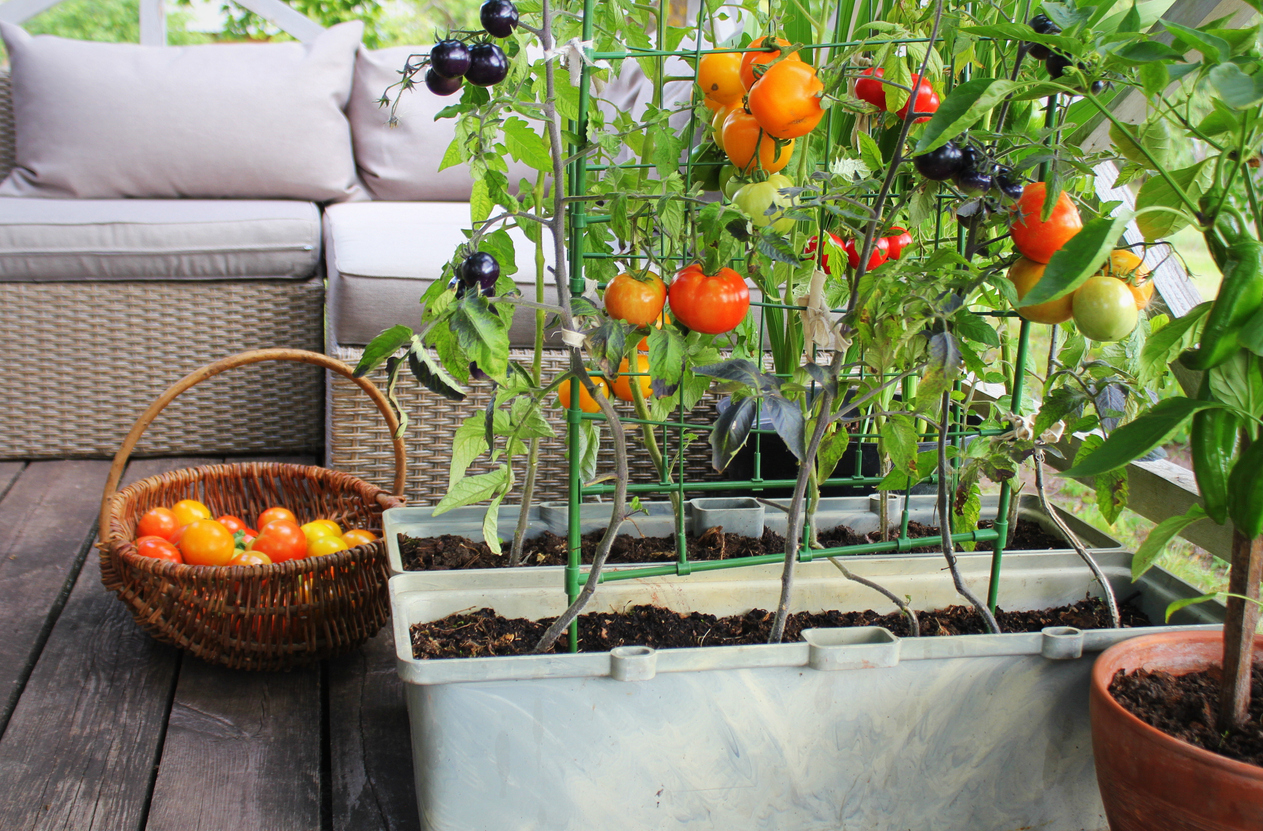In the northeast where I live, there are about 4-5 months of actual gardening, and 7-8 months of planning. I like to plan a garden that is partially in-ground and also a bit above-ground in containers, especially for annual herbs so that I can have them close to the house.
There’s a lot to be said for a container garden. You can move it around to get better light. You can control the type of soil. Weeds aren’t as much of a worry, plus, not everybody has a yard for a garden. And a vegetable garden box can fit pretty much anywhere you need it to. They can be vertical or elevated, you can hang them from your window, and they can be as small or as large as you want.
Whether you have a tiny balcony off your fifth floor apartment, a concrete driveway, or a sunny spot on your deck, container gardens are a valid option for anyone. You can build your own vegetable garden box out of wood, buy a galvanized steel version, or even use an old five-gallon bucket for a “folksy” look. A lot of people seem to think using a box limits what you can grow, but that’s only partially true, and it really depends on all sorts of circumstances in addition to what container you use.
I wanted to experiment with some patio plants and discovered there’s a lot more to a vegetable garden box than how big it is or what it looks like. Here is some of what I’ve learned.
Discover 7 top tips for growing, harvesting, and enjoying tomatoes from your home garden—when you access the FREE guide The Best Way to Grow Tomatoes, right now!
The wide world of vegetable garden box possibilities and what they all mean
First, what is a vegetable garden box? The term is open for definition, but generally speaking, it’s any kind of container in which you plant your vegetable garden. For the purpose of this article, we’re talking about a vegetable garden box with a bottom, not a raised garden with an open bottom that lays on top of the soil.
Box, bin, basket – that part doesn’t matter so much. It can be a fancy raised bed or your old coffee cans. There are some important considerations, though.
Remember, you’re growing vegetables that you will be eating. Think about that when you choose your container. For example, you may not want to use that old paint can or that rusty old cast iron tub you found at the flea market. Here are some other things to think about:
- Container color: A black or dark-colored vegetable garden box will absorb more heat, drying out your soil more quickly and potentially making the soil too hot for the plant roots
- Container size: While a small might be fine for basil or thyme, plants like tomatoes need a lot of space to grow and develop a strong root system.
- Container weight: If you plan to move your vegetable garden box around, or if you plan to hang it, consider the weight. A five-gallon container full of damp soil is pretty darn heavy.
- Container material: There’s no right or wrong here, but consider that a clay pot is nice and porous, while a plastic container probably won’t give you that well-drained soil that some plants require.
Finding success with container gardening is about more than just choosing the right container, though. And if you decide to start out big, it can get expensive quickly. An elevated, self-watering planter can easily be $100 and up, not counting the soil and plants. Your basic four-square foot Cedar frame can start at $50 or more. Of course, cedar will last for years, as will terra cotta pots and most other vegetable garden box materials, so this is usually just an initial expense.
I might add that high-quality soil will make a world of difference, too. It’s worth spending a little extra to buy potting soil that’s designed specifically for a vegetable container garden. Otherwise, you’re going through a lot of work to get possibly disappointing results.
Honestly, even with all this information, I’ve found good old terra cotta pots to be just about perfect for some vegetables, like beans. You can start your beans in pots and throw a trellis behind them, and up they will grow. They’re relatively inexpensive, they come in sizes small enough for a windowsill and large enough to feel like permanent installations. They do tend to suck up water, but that just means I need to be more conscious of how often I water my vegetables and herbs. Plus, you can buy them at pretty much any plant store, home improvement store, and even yard sales.
What to plant in your vegetable garden box
So once you select your container, what can you grow? A window box is ideal for leaf lettuce, herbs, edible flowers, or radishes.
Slightly larger containers are good for Swiss chard, spinach, and peas.
Going up a little in size, you can pole beans, carrots, cucumbers, eggplant, and peppers.
Then for big containers, okra, summer squash, and tomatoes. Just bear in mind that tomatoes can be a bit finicky, and they need lots of space, so choose your variety carefully. Some are more forgiving than others. For container planting tomatoes, I like the bottom of a big wine barrel, myself, with a single tomato plant and tomato tower, surrounded by basil.
No matter where you live, even if you don’t have a big yard, you can enjoy fresh produce on your porch, patio, terrace, or windowsill.
Discover 7 top tips for growing, harvesting, and enjoying tomatoes from your home garden—when you access the FREE guide The Best Way to Grow Tomatoes, right now!
What kind of produce have you grown in a vegetable garden box? I’d love to hear your stories, good and bad, in the comments.
